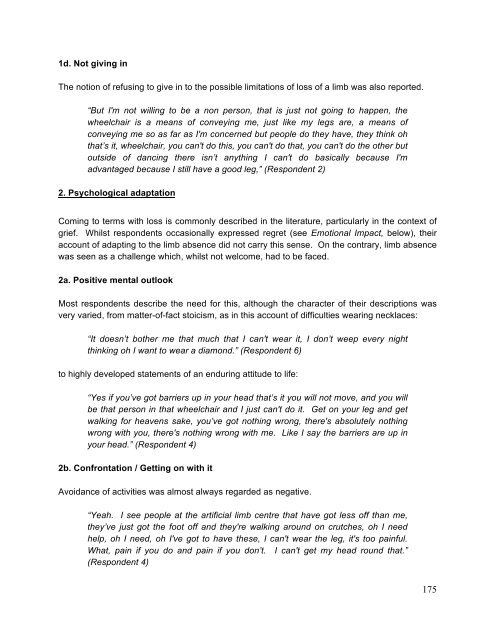Download the report - The Healing Foundation
Download the report - The Healing Foundation
Download the report - The Healing Foundation
You also want an ePaper? Increase the reach of your titles
YUMPU automatically turns print PDFs into web optimized ePapers that Google loves.
1d. Not giving in<br />
<strong>The</strong> notion of refusing to give in to <strong>the</strong> possible limitations of loss of a limb was also <strong>report</strong>ed.<br />
“But I'm not willing to be a non person, that is just not going to happen, <strong>the</strong><br />
wheelchair is a means of conveying me, just like my legs are, a means of<br />
conveying me so as far as I'm concerned but people do <strong>the</strong>y have, <strong>the</strong>y think oh<br />
that’s it, wheelchair, you can't do this, you can't do that, you can't do <strong>the</strong> o<strong>the</strong>r but<br />
outside of dancing <strong>the</strong>re isn’t anything I can't do basically because I'm<br />
advantaged because I still have a good leg,” (Respondent 2)<br />
2. Psychological adaptation<br />
Coming to terms with loss is commonly described in <strong>the</strong> literature, particularly in <strong>the</strong> context of<br />
grief. Whilst respondents occasionally expressed regret (see Emotional Impact, below), <strong>the</strong>ir<br />
account of adapting to <strong>the</strong> limb absence did not carry this sense. On <strong>the</strong> contrary, limb absence<br />
was seen as a challenge which, whilst not welcome, had to be faced.<br />
2a. Positive mental outlook<br />
Most respondents describe <strong>the</strong> need for this, although <strong>the</strong> character of <strong>the</strong>ir descriptions was<br />
very varied, from matter-of-fact stoicism, as in this account of difficulties wearing necklaces:<br />
“It doesn’t bo<strong>the</strong>r me that much that I can't wear it, I don’t weep every night<br />
thinking oh I want to wear a diamond.” (Respondent 6)<br />
to highly developed statements of an enduring attitude to life:<br />
“Yes if you’ve got barriers up in your head that’s it you will not move, and you will<br />
be that person in that wheelchair and I just can't do it. Get on your leg and get<br />
walking for heavens sake, you’ve got nothing wrong, <strong>the</strong>re's absolutely nothing<br />
wrong with you, <strong>the</strong>re's nothing wrong with me. Like I say <strong>the</strong> barriers are up in<br />
your head.” (Respondent 4)<br />
2b. Confrontation / Getting on with it<br />
Avoidance of activities was almost always regarded as negative.<br />
“Yeah. I see people at <strong>the</strong> artificial limb centre that have got less off than me,<br />
<strong>the</strong>y’ve just got <strong>the</strong> foot off and <strong>the</strong>y're walking around on crutches, oh I need<br />
help, oh I need, oh I've got to have <strong>the</strong>se, I can't wear <strong>the</strong> leg, it's too painful.<br />
What, pain if you do and pain if you don’t. I can't get my head round that.”<br />
(Respondent 4)<br />
175


